Al Makahinu Barcarse
Title
Al Makahinu Barcarse
Subject
Nā Kumu Hula Al Makahinu Barcarse - Nānā I Nā Loea Hula Volume 2 Page 17
Description
Al Makahinu Barearse
Al Barearse has realized his dream of building a Hawaiian village on the grounds of the Samuel Wilder King Intermediate School where he is employed as a Hawaiian Studies teacher.
I was born and raised in Waimea, Kaua‘i and attended Waimea High School. Hula was taught to us in the sixth grade as part of the school curriculum. My actual formal training began in 1951 with Leolani Rivera, Larry Riveraʻs sister. She taught hula kahiko, ‘auana, Maori, and Tahitian dance and in 1957 I received my kumu hula certificate from her.
After graduating from high school I attended tin; Church College of Hawaiʻi and continued my hula training under Christina Nauahi, a kumu hula in Lāʻie who also taught a lot of Maori dances. While attending the Church College I formed a group and taught them hula. We first performed at school functions and then for the hukilau at Lā‘ie Bay. Our group became a regular special guest for John Piʻilani Watkins’ show at the Club Aloha. Then in 1959 we started performing at Don the Beachcomber Show, our first professional gig.
In 1959 Rose Joshua contacted me because she wanted to learn Maori. I taught Maori at her studio and she in turn taught me hula. I took formal lessons from her for two years and then informally for five more years. Whenever she needed me, she would call. Besides dancing and teaching Maori. I also chanted for her. Both George Holokai and Henry Pa were affiliated with Rose Joshua and as a result I learned some chants and dances from them as well.
In 1963 Jack Regas hired me as his assistant choreographer for the Polynesian Cultural Center. Aunty Sally Wood was in charge of the Hawaiian section so I studied under her for two years. Because Aunty Sally and Grandma Rose Joshua were hula sisters, their styles were basically the same.
I got involved with teaching school kids when I was at Kalani High School. I was student teaching and I organized a group call the “Na Makahinu to do shows at the Outrigger Canoe Club, Sea Life Park, Hilton Hawaiian Village, and Hula Hut. As a group we toured Japan, I long Kong, Philippines, Australia, New Zealand, and Tahiti.
My sons, who also took hula from me, talked me into entering the Merrie Monarch Festival when I was teaching at Kaimukī High School. The first year we entered, we took a group consisting of football players and cheerleaders. After Kaimukī I went to Moloka‘i as a district resource teacher of Hawaiian Studies for a year and returned to Oʻahu and taught at Mililani High School, Castle High School, and am now presently at King Intermediate. I have entered the students in the Merrie Monarch Festival from all of the schools that I’ve taught at.
Besides teaching Hawaiian language and Pacific Islands Studies al King Intermediate School, I teach hula during the first semester and other Polynesian dances the second semester. One of our regular community service projects is to perform at five different care homes during Christmas and Easter. I feel it is important for the students to perform for our senior citizens. A lot of my students come from broken homes and feel that they have no purpose in life. When they see the audience enjoy their performance, they know that they’ve done something worthwhile and feel good about themselves.
The name of my hālau Ka Ua Kilihune means, “the life giving rain. It rains all the time in the mountains and it keeps the mountains green and alive. I relate to this rain because I have devoted my life to keeping Hawai'i alive by teaching hula to the children. One of my mottos is, “It matters not what happens to you, but rather what happens to them if you do not get involved.”
Uncle George Nāʻope had the greatest influence on my hula career. When I decided to give up hula, he was the person who encouraged me to continue. He helped me on my way and became my mentor and my teacher.
The things that I’ve learned from my kumu hula I try not to change. Keeping the dance intact is sacred as far as I’m concerned. I will create motions for other chants but I think I am basically influenced by what I’ve learned from my kumu hula.
At one time in our history nothing was written down. There was no written language and everything had to be memorized. Dancing the hula to all of the ancient chants has made those things become real. The easiest way to memorize our history is by doing it through the hula. Hula keeps our history and our people alive, and without it one cannot truly identify oneself as being Hawaiian.
“Uncle George Nāʻope had the greatest influence on my hula career. When I decided to give up hula, he was the person who encouraged me to continue.”
Al Barearse has realized his dream of building a Hawaiian village on the grounds of the Samuel Wilder King Intermediate School where he is employed as a Hawaiian Studies teacher.
I was born and raised in Waimea, Kaua‘i and attended Waimea High School. Hula was taught to us in the sixth grade as part of the school curriculum. My actual formal training began in 1951 with Leolani Rivera, Larry Riveraʻs sister. She taught hula kahiko, ‘auana, Maori, and Tahitian dance and in 1957 I received my kumu hula certificate from her.
After graduating from high school I attended tin; Church College of Hawaiʻi and continued my hula training under Christina Nauahi, a kumu hula in Lāʻie who also taught a lot of Maori dances. While attending the Church College I formed a group and taught them hula. We first performed at school functions and then for the hukilau at Lā‘ie Bay. Our group became a regular special guest for John Piʻilani Watkins’ show at the Club Aloha. Then in 1959 we started performing at Don the Beachcomber Show, our first professional gig.
In 1959 Rose Joshua contacted me because she wanted to learn Maori. I taught Maori at her studio and she in turn taught me hula. I took formal lessons from her for two years and then informally for five more years. Whenever she needed me, she would call. Besides dancing and teaching Maori. I also chanted for her. Both George Holokai and Henry Pa were affiliated with Rose Joshua and as a result I learned some chants and dances from them as well.
In 1963 Jack Regas hired me as his assistant choreographer for the Polynesian Cultural Center. Aunty Sally Wood was in charge of the Hawaiian section so I studied under her for two years. Because Aunty Sally and Grandma Rose Joshua were hula sisters, their styles were basically the same.
I got involved with teaching school kids when I was at Kalani High School. I was student teaching and I organized a group call the “Na Makahinu to do shows at the Outrigger Canoe Club, Sea Life Park, Hilton Hawaiian Village, and Hula Hut. As a group we toured Japan, I long Kong, Philippines, Australia, New Zealand, and Tahiti.
My sons, who also took hula from me, talked me into entering the Merrie Monarch Festival when I was teaching at Kaimukī High School. The first year we entered, we took a group consisting of football players and cheerleaders. After Kaimukī I went to Moloka‘i as a district resource teacher of Hawaiian Studies for a year and returned to Oʻahu and taught at Mililani High School, Castle High School, and am now presently at King Intermediate. I have entered the students in the Merrie Monarch Festival from all of the schools that I’ve taught at.
Besides teaching Hawaiian language and Pacific Islands Studies al King Intermediate School, I teach hula during the first semester and other Polynesian dances the second semester. One of our regular community service projects is to perform at five different care homes during Christmas and Easter. I feel it is important for the students to perform for our senior citizens. A lot of my students come from broken homes and feel that they have no purpose in life. When they see the audience enjoy their performance, they know that they’ve done something worthwhile and feel good about themselves.
The name of my hālau Ka Ua Kilihune means, “the life giving rain. It rains all the time in the mountains and it keeps the mountains green and alive. I relate to this rain because I have devoted my life to keeping Hawai'i alive by teaching hula to the children. One of my mottos is, “It matters not what happens to you, but rather what happens to them if you do not get involved.”
Uncle George Nāʻope had the greatest influence on my hula career. When I decided to give up hula, he was the person who encouraged me to continue. He helped me on my way and became my mentor and my teacher.
The things that I’ve learned from my kumu hula I try not to change. Keeping the dance intact is sacred as far as I’m concerned. I will create motions for other chants but I think I am basically influenced by what I’ve learned from my kumu hula.
At one time in our history nothing was written down. There was no written language and everything had to be memorized. Dancing the hula to all of the ancient chants has made those things become real. The easiest way to memorize our history is by doing it through the hula. Hula keeps our history and our people alive, and without it one cannot truly identify oneself as being Hawaiian.
“Uncle George Nāʻope had the greatest influence on my hula career. When I decided to give up hula, he was the person who encouraged me to continue.”
Citation
“Al Makahinu Barcarse,” Nā Kumu Hula Archive, accessed August 25, 2025, https://nakumuhula.org/archive/items/show/106.






